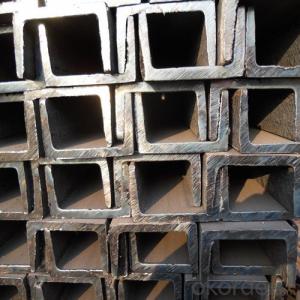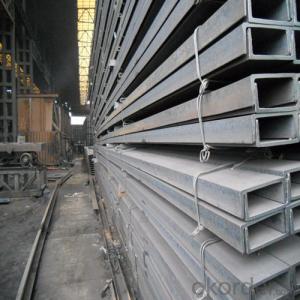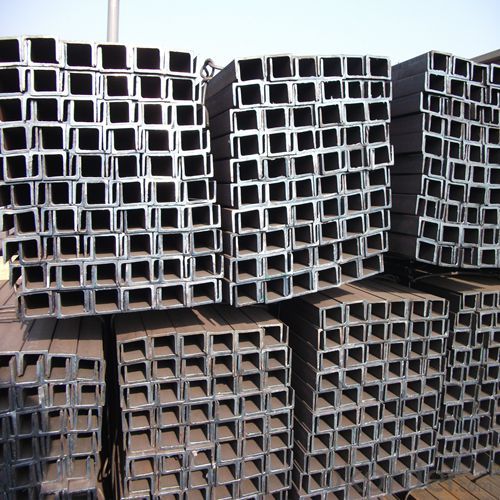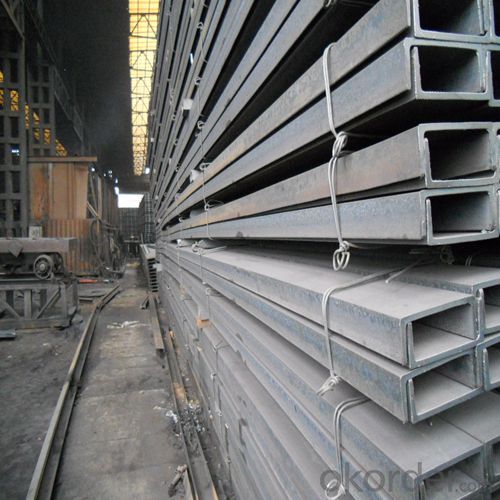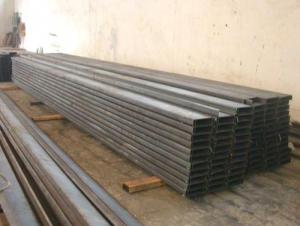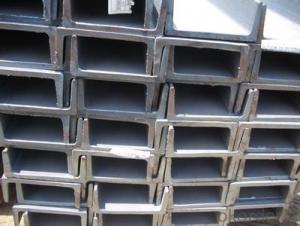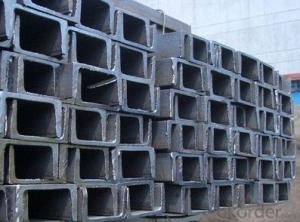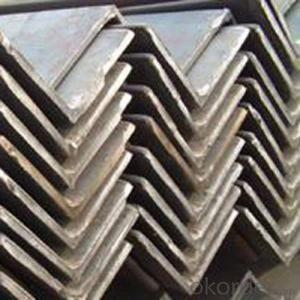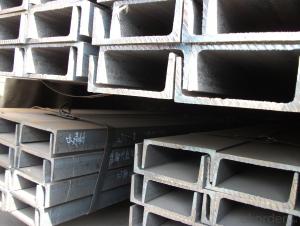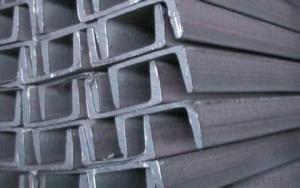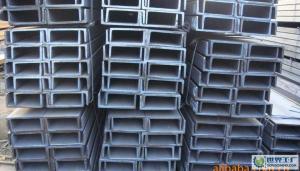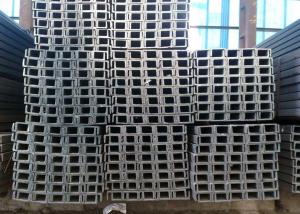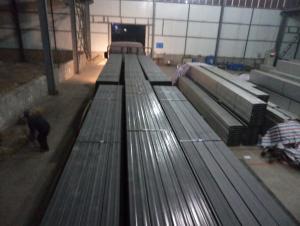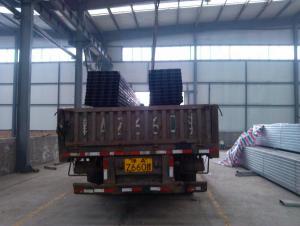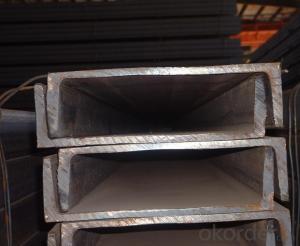Hot Rolled Channel Steel Bar U Channel JIS Q235
- Loading Port:
- Tianjin
- Payment Terms:
- TT or LC
- Min Order Qty:
- 50 m.t.
- Supply Capability:
- 30000 m.t./month
OKorder Service Pledge
OKorder Financial Service
You Might Also Like
Product Description:
OKorder is offering Hot Rolled Channel Steel Bar U Channel JIS Q235 at great prices with worldwide shipping. Our supplier is a world-class manufacturer of steel, with our products utilized the world over. OKorder annually supplies products to European, North American and Asian markets. We provide quotations within 24 hours of receiving an inquiry and guarantee competitive prices.
Product Applications:
Hot Rolled Channel Steel Bar U Channel JIS Q235 are ideal for structural applications and are widely used in the construction of buildings and bridges, and the manufacturing, petrochemical, and transportation industries.
Product Advantages:
OKorder's Hot Rolled Channel Steel Bar U Channel JIS Q235 are durable, strong, and resist corrosion.
Main Product Features:
· Premium quality
· Prompt delivery & seaworthy packing (30 days after receiving deposit)
· Corrosion resistance
· Can be recycled and reused
· Mill test certification
· Professional Service
· Competitive pricing
Product Specifications:
Specifications of MS Channel:
1.We supply high quality MS Channel at reasonable price, including Chinese standard, Japanese standard and so on.
Standard | GB/JIS |
Material Grade | Q235,SS400 |
Technique: | Hot Rolled |
Sizes as per chinese standard: | 50*37*4.5mm - 300*89*11.5mm |
Sizes as per japanese standard: | 50*25*3mm – 200*80*7.5mm |
Length: | 6meter, 9meter, 12meter |
Note: 1.we are also competent to provide our customers other MS Channel based on other sizes according to customer’s requirements.
2. The length of our ms channel could be cut into other meters as per customer’s requirements. For example, the channel in 6meters could be cut into 5.8meters in order to be fit in the 20ft container.
2. The detailed sections of MS Channel as per GB standard.are shown in the table-1:
GB U CHANNEL | Standard | Sectional | Dimension |
| Mass: |
| (mm) | (mm) | (mm) | (mm) |
|
50X37 | 50 | 37 | 4.50 | 7.0 | 5.438 |
63X40 | 63 | 40 | 4.80 | 7.5 | 6.634 |
80x43 | 80 | 43 | 5.00 | 8.0 | 8.045 |
|
|
|
|
|
|
100x48 | 100 | 48 | 5.30 | 8.5 | 10.007 |
120x53 | 120 | 53 | 5.50 | 9.0 | 12.059 |
140x58 | 140 | 58 | 6.00 | 9.5 | 14.535 |
140x60 | 140 | 60 | 8.00 | 9.5 | 16.733 |
|
|
|
|
|
|
160x63 | 160 | 63 | 6.50 | 10.0 | 17.240 |
160x65 | 160 | 65 | 8.50 | 10.0 | 19.752 |
|
|
|
|
|
|
180x68 | 180 | 68 | 7.00 | 10.5 | 20.174 |
180x70 | 180 | 70 | 9.00 | 10.5 | 23.000 |
|
|
|
|
|
|
200x73 | 200 | 73 | 7.00 | 11.0 | 22.637 |
200x75 | 200 | 75 | 9.00 | 11.0 | 25.777 |
|
|
|
|
|
|
220x77 | 220 | 77 | 7.00 | 11.5 | 24.999 |
220x79 | 220 | 79 | 9.00 | 11.5 | 28.453 |
|
|
|
|
|
|
250x78 | 250 | 78 | 7.00 | 12.0 | 27.410 |
250x80 | 250 | 80 | 9.00 | 12.0 | 31.335 |
250x82 | 250 | 82 | 11.00 | 12.0 | 35.260 |
|
|
|
|
| |
280x82 | 280 | 82 | 7.50 | 12.5 | 31.427 |
280x84 | 280 | 84 | 9.50 | 12.5 | 35.823 |
280x86 | 280 | 86 | 11.50 | 12.5 | 40.219 |
|
|
|
|
|
|
300x85 | 300 | 85 | 7.50 | 13.5 | 34.463 |
300x87 | 300 | 87 | 9.50 | 13.5 | 39.173 |
300x89 | 300 | 89 | 11.50 | 13.5 | 43.883 |
Table-1
3. The chemical composition of HR Channel Steel according to Q235B is shown in Table-2.
Alloy No | Grade | Element(%) | ||||
C | Mn | S | P | Si | ||
Q235 | B | 0.12-0.20 | 0.3-0.7 | ≦0.045 | ≦0.045 | ≦0.3 |
Table-2
Note: we are able to present our customers relevant SGS test report for chemical composition of HR Channel Steel.
4. The mechanical property of HR Channel Steel according to Q235B is shown in Table-3-1 and Table-3-2
Alloy No | Grade | Yielding Strength Point(Mpa) | |||
Thickness(mm) | |||||
≦16 | >16-40 | >40-60 | >60-100 | ||
≧ | |||||
Q235 | B | 235 | 225 | 215 | 205 |
Table-3-1
Alloy No | Grade | Tensile Strength(Mpa) | Elongation After Fracture(%) | |||
Thickness(mm) | ||||||
≦16 | >16-40 | >40-60 | >60-100 | |||
≧ | ||||||
G235 | B | 375-500 | 26 | 25 | 24 | 23 |
Table-3-2
Note: we are able to present our customers relevant SGS test report for mechanical property of MS Channel as customer’s request.
Applications of MS Channel:
The MS Channel can be applied to construction of warehouses, workshops, sport stadiums and car parks etc.The hot rolled channel steel belongs to carbon structural steel which is applied to in the field of construction and machinery.In details, the hot rolled channel steel is usually used for arch-itechtural structure, and they could be welded in order to support or hang a vari-ety of facilities. They are also usually used in combination with I beam. Generally,the hot rolled channel steel we supply must possess perfect welding property, riveting property and mechanical property and so on.
Package & Delivery of MS Channel:
1.The hot rolled channel steel will be packed in bundle with steel wire at each end of every bundle and color marking in order to help the customer to recognize his goods more easily at sight.
2. And the hot rolled channel steel could be loaded into 20ft or 40ft container, or by bulk cargo.If the weight of each bundle reaches more than 3.5 mt, the loading by break bulk cargo should be choosed.When the weight of each bundle reaches less than 3mt, the loading by container should be choosed.
3.As for the transportaion from mill to loading port, the truck will be usually used. And the maximum quantity for each truck is 40mt.
4.All in all, we could do in accordance with customer's request
FAQ:
Q1: Why buy Materials & Equipment from OKorder.com?
A1: All products offered byOKorder.com are carefully selected from China's most reliable manufacturing enterprises. Through its ISO certifications, OKorder.com adheres to the highest standards and a commitment to supply chain safety and customer satisfaction.
Q2: How do we guarantee the quality of our products?
A2: We have established an advanced quality management system which conducts strict quality tests at every step, from raw materials to the final product. At the same time, we provide extensive follow-up service assurances as required.
Q3: How soon can we receive the product after purchase?
A3: Within three days of placing an order, we will begin production. The specific shipping date is dependent upon international and government factors, but is typically 7 to 10 workdays.
Q4: What makes stainless steel stainless?
A4: Stainless steel must contain at least 10.5 % chromium. It is this element that reacts with the oxygen in the air to form a complex chrome-oxide surface layer that is invisible but strong enough to prevent further oxygen from "staining" (rusting) the surface. Higher levels of chromium and the addition of other alloying elements such as nickel and molybdenum enhance this surface layer and improve the corrosion resistance of the stainless material.
Q5: Can stainless steel rust?
A5: Stainless does not "rust" as you think of regular steel rusting with a red oxide on the surface that flakes off. If you see red rust it is probably due to some iron particles that have contaminated the surface of the stainless steel and it is these iron particles that are rusting. Look at the source of the rusting and see if you can remove it from the surface.
Images:
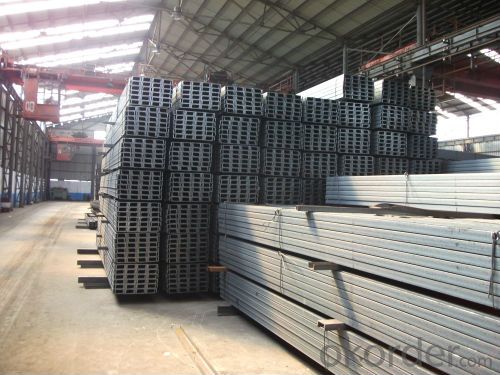
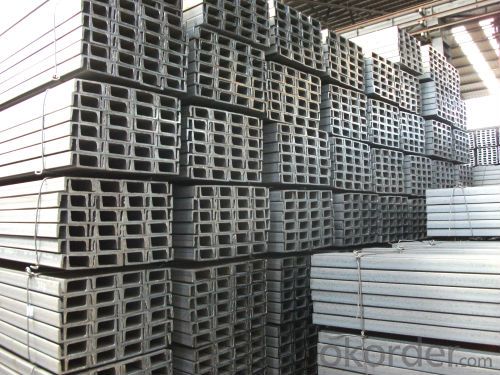
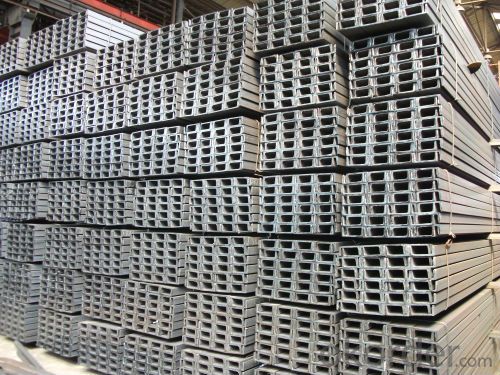
- Q: How do you calculate the deflection of steel channels?
- The deflection of steel channels can be calculated using the formula for beam deflection, which takes into account factors such as the material properties, dimensions, and applied load. This formula typically involves the use of equations derived from structural engineering principles, such as the Euler-Bernoulli beam theory or the Timoshenko beam theory. By plugging in the relevant parameters into the appropriate equations, one can determine the deflection of steel channels under specific loading conditions.
- Q: How are steel channels used in the manufacturing of machinery?
- Steel channels are commonly used in the manufacturing of machinery as structural components that provide strength, support, and stability. They are often used to create frames, bases, and supports for various machine parts and components. Steel channels help ensure the structural integrity of the machinery, allowing it to withstand heavy loads and vibrations during operation. Additionally, they can be used to guide and direct movement, such as in conveyor systems or assembly lines. Overall, steel channels are essential in the manufacturing of machinery to enhance its durability and functionality.
- Q: Can steel channels be used for equipment supports?
- Indeed, equipment supports can make use of steel channels. In construction and industrial settings, steel channels are widely employed due to their robustness and durability. They are capable of providing steadfast and dependable support for a range of equipment, including heavy machinery, tools, and other substantial loads. These steel channels are specifically designed to endure substantial loads and can be easily customized and installed to meet specific support requirements. Furthermore, they can be combined with other structural components, such as beams and columns, to establish a resilient support system. All in all, steel channels serve as a dependable solution for equipment supports, owing to their strength, versatility, and enduring performance.
- Q: What are the disadvantages of using steel channels?
- Some disadvantages of using steel channels include their relatively high cost compared to other materials, their susceptibility to corrosion if not properly protected or maintained, and their limited versatility in terms of shapes and sizes available. Additionally, steel channels may require specialized equipment and expertise for installation and may not be suitable for certain applications where weight reduction is important.
- Q: Is channel steel expensive or angle expensive?
- If the loading requirement is not high, then use the angle iron is good, with angle steel to save money, channel steel beam ah, what is more. Relatively high bearing capacity. Landlord mainly in the right place, with the right products, the most economical, and rely on live.
- Q: Can steel channels be used in DIY projects?
- Yes, steel channels can be used in DIY projects. Steel channels are versatile and can be utilized in a variety of applications such as constructing frames, supports, shelving, and even furniture. They are strong, durable, and can provide structural stability to your DIY projects. Additionally, steel channels are available in various sizes and shapes, allowing you to find the perfect fit for your specific project requirements. Whether you are working on a small-scale DIY project or a larger construction undertaking, steel channels can be a valuable addition to your arsenal of materials.
- Q: What are the different quality control measures for steel channels?
- There are several quality control measures for steel channels that ensure their strength, durability, and overall quality. Some of these measures include conducting visual inspections to check for any defects or imperfections, performing dimensional checks to ensure accurate measurements, conducting mechanical tests to assess the strength and load-bearing capacity, and implementing surface treatment processes to prevent corrosion and enhance the appearance. Additionally, steel channels may undergo non-destructive testing methods such as ultrasonic or magnetic particle inspections to detect any internal flaws. Overall, these quality control measures help guarantee that steel channels meet the desired specifications and industry standards.
- Q: Are steel channels suitable for load-bearing walls?
- Typically, steel channels are not suitable for load-bearing walls. These walls are designed to bear the weight of a building or other structural elements, so they require materials that possess high compressive strength and stability. Steel channels, also referred to as C-channels or U-channels, are commonly utilized for non-structural purposes such as framing and supporting secondary components like cladding or drywall. They lack the necessary structural properties to withstand heavy loads and may not provide the required stability and rigidity. Load-bearing walls are typically constructed using materials like concrete, masonry, or steel beams that are specifically engineered to handle the forces involved in supporting a structure.
- Q: What are the different grades of steel channels?
- Steel channels come in various grades, each possessing unique properties and applications. Some commonly used grades are as follows: 1. A36: The most widely used grade, A36 steel channel finds its application in construction and structural projects. It boasts a minimum yield strength of 36,000 psi and is easily machinable and weldable. 2. A572: A high-strength, low-alloy (HSLA) steel channel grade, A572 offers superior strength and durability compared to A36. It is commonly employed in heavy-duty applications like bridges and buildings. 3. A588: This grade is renowned for its corrosion resistance, making it ideal for outdoor or exposed environments. It is frequently utilized in construction projects exposed to harsh weather conditions. 4. A709: Another HSLA steel channel grade, A709 provides high strength and enhanced corrosion resistance. It is commonly used in bridge construction and other structural applications. 5. A992: A high-strength, low-alloy steel channel grade, A992 is frequently employed in construction and structural projects. It possesses higher yield and tensile strength than A36, making it suitable for heavy-duty applications. 6. Stainless Steel: Apart from carbon steel channels, stainless steel channels are also available in grades like 304 and 316. These grades offer excellent corrosion resistance and are commonly used in industries such as food processing, pharmaceuticals, and marine applications. Selecting the appropriate grade of steel channel is crucial, considering factors like strength, corrosion resistance, and environmental conditions. Consulting a structural engineer or steel supplier can assist in determining the most suitable grade for a specific application.
- Q: The back of the channel steel deviates from the 30mm. The upper and lower iron plates are welded at intervals. Is the cross section resistance moment the sum of the two? No, is it big or small? Thank you
- The direction of the X axis distance of the centroid and centroid of single channel and two channel combination from coincidence (the same), so the moment of inertia of the two combinations of two single channel channel is equal to the moment of inertia and resistance moment and is also. (resistance moment = moment of inertia / centroid distance)The Y axis direction, back to the departure from the 30mm two, the centroid distance than the centroid of the single channel combination channel distance increases 15mm, moment of inertia is the centroid distance square by channel section, so a combination of two channel resistance moment is far greater than the two single channel and.
Send your message to us
Hot Rolled Channel Steel Bar U Channel JIS Q235
- Loading Port:
- Tianjin
- Payment Terms:
- TT or LC
- Min Order Qty:
- 50 m.t.
- Supply Capability:
- 30000 m.t./month
OKorder Service Pledge
OKorder Financial Service
Similar products
Hot products
Hot Searches
Related keywords

